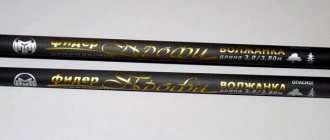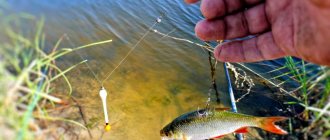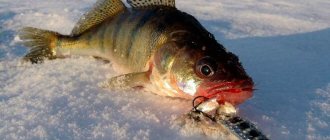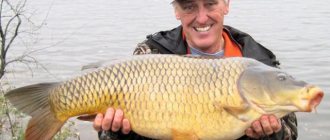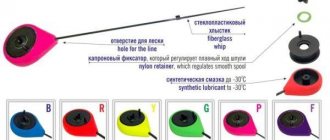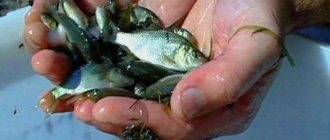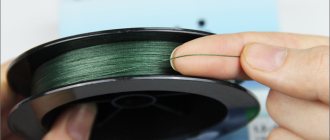Catching pike perch with live bait is one of the most productive and interesting ways to catch a fanged predator. Despite its passivity, live bait fishing is not much inferior in its catchability, weight and quantity of fish caught, and in some cases even surpasses sports jig or twitch fishing, as well as trolling.
Advantages and disadvantages of the method
The use of live bait allows you to catch pike perch not only during periods of high predator activity, but even when the use of various artificial baits does not produce any results.
The main advantages of this fishing method are:
- Active and naturalistic movement in the water column of a fry mounted on a double or tee. No artificial bait can fully imitate the movements of a live fish.
- Cheapness and simplicity of the equipment used. For live bait fishing, you can use inexpensive rods, reels, simple but strong monofilament line or braided cord.
- Possibility of simultaneous use of several gears. Since live bait fishing is stationary, this allows you to use 2 or more gear at the same time. At the same time, a very large area of water is fished and the chance of catching fish increases.
- Stationarity and relatively low labor intensity. Live bait fishing, unlike fishing for pike perch with a spinning rod, does not involve frequent casting and retrieving. This makes this type of fishing less tiring and time-consuming, which many people like, especially older fishermen.
- High catchability. Using live bait allows you to catch pike perch not only during periods of high predator activity. There are situations when the use of various silicone baits or pike-perch wobblers does not produce results.
Disadvantages of fishing with live bait:
- Using sufficiently voluminous fishing equipment - a small fish, eland or other vessel for storing live bait;
- High cost of live bait in fishing stores;
- A long process of independent production of fry;
- During the fishing process, it is necessary to monitor the condition of the live bait - often change the water, throw out dead fish that have floated up with their bellies, place the kana with bait in a shady place not illuminated by the sun.
We recommend reading: Winter gear helicopter
On a note ! Live bait fishing, unlike spinning, allows you to catch larger trophy pike perch. The weight of specimens caught with live bait reaches 5 kilograms or more, while 2-3 kilogram pike perch are usually caught with artificial bait.
Feeder fishing for pike perch
A predator feeder is used by many fishermen as an alternative to bottom gear. When choosing a feeder rod, you should pay attention to the tips. They are also called quivertypes. For fast water, choose a stiffer tip; for still water and for weak currents, choose a softer and more sensitive tip. The length of the rod is chosen within the range of 3.7-4 m with a test weight of at least 120 g. To catch pike perch on a feeder, it is advisable to use equipment with a sliding weight. If you plan to fish in places with many obstacles, install the sinker using an additional leash. The best option for a sinker is narrow and long.
When setting up the reel, you need to make sure that the rod tip does not bend too much, and the fish can easily remove the line from the reel. If catching a predator on a feeder occurs at night, then it is advisable to use a bite alarm. The reel chosen is a spinning reel with a size of 3000-5000. When fishing in still water, the load on the predatory feeder is chosen in the range of 60-80 g, for currents at least 100 g.
Feeder equipment can be almost anything. The main thing is to pay attention to the fishing line when choosing: it should not be too thin, at least 0.3 mm. If braid is used, the minimum diameter should be 0.2 mm. If you plan to catch pike on a feeder, then a steel leash should be used. To fill the feeder feeder, you can use a variety of baits, for example, a mixture of fish pieces and breadcrumbs. Crackers will attract small things, and fish will attract predators. A variety of bait can be used. Dead fish, live bait, or chopped pieces of fish are used as bait. After casting, the rod must be positioned so that the bait does not lie on the bottom. Casting should be done at least every 20-25 minutes. This is how pike perch is caught on a feeder.
Getting pike perch is often a challenging task for beginners. However, the considered methods and gear for catching predators will help you understand and figure out when and what you can catch this fish with. There are other options, and there are many of them. The most common ones that will appeal to most fishing enthusiasts have been listed above. And for those who love sophisticated fishing, we can offer fishing with rafting on a boat, trolling, fishing with a line, etc.
Choosing a place and time of fishing
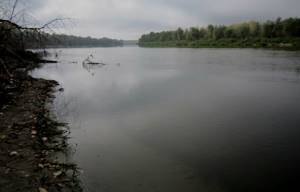
The most promising places for live bait fishing are:
- Snagged and littered river holes and whirlpools;
- The lower edges of the slopes of channel pits within the reaches;
- Coastal ditches under steep banks;
- Deep areas with a hard sandy, clayey, pebble or shell bottom.
Small pike-perch along with small perch are often found on sandy shallows that are partially overgrown with grass.
Fanged fish are caught in this way throughout the open water season. The most active bite for live bait is in the summer, at the end of May - beginning of June and in the fall, until mid-October. With a sharp drop in water temperature, pike perch slide into deep wintering holes, where they spend most of the winter.
On a note! To catch pike perch, choose areas with medium currents, deep places on the border of the main and reverse streams.
Basic fishing gear
In live bait fishing, such gear as a donka, a float rod, a girder, and mugs are used.
Donka
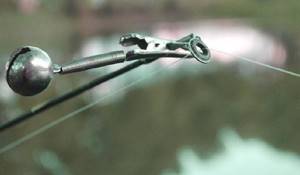
To notify the fisherman about a bite in such gear, ordinary bells or electronic alarms are used.
Bottom tackle for fishing with live bait consists of:
- A rigid spinning rod 2.4-3.0 meters long or a “river” 360-390 centimeter feeder;
- Spinning reels size 3000;
- Main monofilament line with a cross section of 0.35 mm;
- Fasteners (carbine) with a swivel tied at the end of the main fishing line;
- 80-110 gram flat sinker with protrusions with lugs fastened to a carabiner at the end of the main fishing line;
- A leash made of monofilament with a cross section of 0.27-0.3 mm and a length of 70-100 cm is tied 20-25 cm above the sinker. The leash is equipped with a single hook No. 2/0-1/0.
To notify the fisherman about a bite in such gear, ordinary bells or electronic alarms are used.
We recommend reading: Mandula tackle for pike perch
Float rod
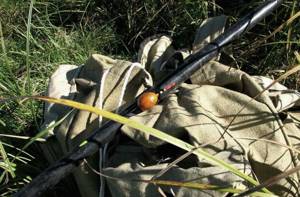
Live bait float tackle consists of a rigid match or Bolognese rod with a length of 3 to 4-4.5 meters, a spinning reel of size 2000-2500 with a 40-50 meter supply of monofilament with a thickness of 0.25-0.3.0 mm. When fishing with such gear, the sinker is allowed to sink to the bottom after casting. Install the float so that it lies completely on the water surface. Such loading of the alarm is done in order to reduce the influence of waves or wind on it, making the bite noticeable even from a distance of 15-20 meters.
Zherlitsa
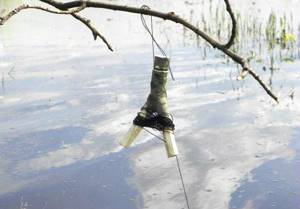
This gear is used when fishing for pike perch in snag holes located near the shore and whirlpools, under steep yars.
For river fishing, a triple swivel rig is used, to two perpendicular rings of which a leash and a piece of fishing line with a flat sinker weighing up to 40-60 grams are tied.
How to catch pike perch on a feeder
The rig always alerts the predator. To catch fish, use something that your target cannot sense. This also applies to the choice of bite alarm. It is easier to catch walleye on a feeder with dead fish.
Feeder rods were created to catch fish species with feeders that are not predators. But today it is actively used when hunting for pike perch, and this has a number of advantages. They also throw baits with a large mass. These rods are distinguished by the presence of a flexible tip, which allows you to get an accurate bite signal. The tops are selected depending on the strength of the current. In strong currents you need to use a rigid tip. For weak currents, a soft tip is suitable.
Tips for fishermen:
- If you catch a predator where there are many obstacles in the water, the sinkers need to be mounted on a side leash, which is thinner than the fishing line.
- Use a sinker that has a central hole.
- Fastening with a toothpick allows the sinker to be pulled off the leader if it gets stuck.
- It is better to use lead or brass sticks as they will not get stuck in the water.
- Use a reel with a free spool with two clutches. It is installed so that the tip of the feeder deviates slightly when biting.
- Use a leash up to 80 cm long.
- Dead fish or strips of it are also suitable for bait. Regular bait will also work.
If you choose a standard bait, it quickly attracts different fish. The pike perch takes advantage of this and begins its hunt. Experienced fishermen claim that if you choose a suitable place and use active bait, you can catch several valuable specimens.
Pike perch is a schooling fish, which is something you need to take advantage of when fishing. The main thing is to interest him in the bait. Playing with bait will allow you to lure out of a hole or depth.
To catch a predator, it is better to use a feeder tackle with a sliding weight. Choose places where the current is fast.
About bait
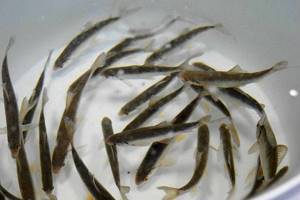
The most suitable bait for such fishing is a small live fish. It is desirable that the proposed live bait be familiar to the pike perch and look as natural as possible.
What live baits are suitable for catching pike perch?
To catch pike perch, use such live bait with a narrow, slender body as:
- Bleak;
- Verkhovodka;
- Minnow;
- Tulka;
- Gudgeon;
- Carpenter;
- Okushok;
- Little ruff.
More tenacious crucian carp, rudd and bream are not used, since they have a rather wide body and rarely become prey for pike perch.
The optimal length of live bait used is from 7-8 to 10 cm.
Where to get live bait
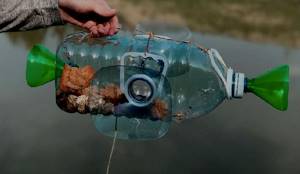
The fry are usually caught in the same body of water in which they plan to fish in the future. It is mined in two main ways:
- a light float fishing rod with thin equipment - a line no more than 0.12 mm thick, a light float with a weight of 0.5 grams, a thin leash with hook No. 18-20;
- whelp with a mesh mesh size of no more than 10 mm.
An alternative device for catching live bait can be a plastic bottle with holes made with an awl, in which the cut neck is inserted so that its wide part faces outward.
To catch live bait, a little bait or white bread crumb is poured inside such a device and, tied with a rope to a long stick, it is lowered horizontally to the bottom of the shallows. Live bait, attracted by bait or bread crumbs, willingly swims through the funnel neck inside the bottle, but cannot swim out.
Recommended reading: Catching burbot with a snitch
Live bait bait methods
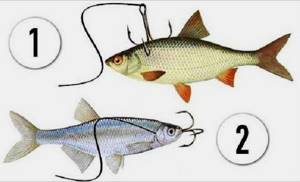
There are several ways to place live bait on a hook:
- Behind the back - with a hook they pierce the back of the fry, while trying not to damage its spine;
- Through the gills - the fishing line segment of the leash is passed through the gills of the fry and taken out of its mouth. After that, a double hook is tied, which is fixed in the mouth of the baitfish by pulling the leash in the opposite direction.
In some cases, the fry is simply caught by the lip. Pierce the upper or lower lip of the fish, bringing the sting of the hook out.
Night fishing with live bait
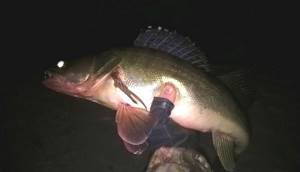
At night, pike perch are caught using live bait both from the shore and from a boat. For boat fishing, they use mugs with fireflies placed on the masts for better visibility and small pieces of reflective material wrapped around them. For fishing from the shore, spinning rods up to 3 meters long are used.
You can catch pike perch at night using live bait in places with holes, dumps, and irrigation areas bordering the depths.
When fishing for pike perch with live bait, you should remember that you cannot take fish the size of the fishing standard established by law (40 cm). By catching fish less than this limit, the fisherman causes enormous harm to the pike perch population and risks being seriously punished by environmental authorities.
Catching Pike on a Float. Nuances and Specifics
Any avid angler knows that there is no more effective and practical way than catching pike with live bait. The fact is that often the predator simply does not react to the artificial baits it uses, preferring live bait.
With this method, it becomes possible to become the owner of a serious, large trophy, which is unlikely to be obtained even with the use of unique fishing technologies.
Simulating Prey for a predator with maximum realism, live bait is capable of provoking even a timid and low-active predator to come out.
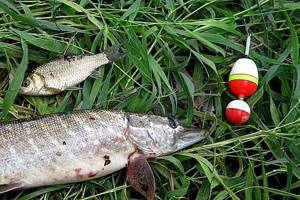
Of course, certain skills and knowledge of specific fishing areas are the main requirements. This will allow you to get maximum pleasure from the process in the warm season using “liquid water” and many pleasant hours alone with nature.
And so that the result is Guaranteed, let’s look at the numerous Nuances and Specifics of this type of fishing.
Float equipment for live bait. Important Requirements
And perhaps it’s worth starting with the Equipment. Despite the availability of the method in question and its relatively apparent simplicity, there are requirements for the equipment used.
First of all, this concerns the reliability of the leash. Its material must be strong enough to withstand tension. In addition, the Pike should not be able to bite it. And having a good, sharp Hook is a must.
A classic, float fishing rod is used as the angler's main tool when fishing for pike with live bait.
The simultaneous combination of Simplicity of design and Efficiency puts it on a par with Mugs and even with the Samolovnaya zherlitsa.
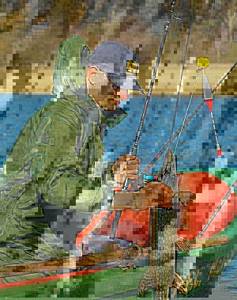
When choosing a fishing rod, keep in mind that its length should not exceed 3.5-4 meters. This has a big role when playing fish;
As for the reel, it is better to use a model that allows you to release the line in case of a bite. This is explained by the weakening of tension and pronounced tension of the fishing line, which increases the chance of successful hooking. Thus, the predator will be able to swallow the offered bait well in the place with the hook.
But the practice of using a rod without a reel is not recommended. By doing this, you will only greatly increase the risk of your gear breaking or your bait being spit out by a predator.
Attention must also be paid when choosing a float. For example, this concerns the ability to stay on the mirror surface of water. First of all, it must provide minimal, additional resistance in the event of a bite. At the same time, good bait retention must be ensured.
Therefore, if you wanted to use a Light Float for this purpose, give up this idea. Even a small, weakened baitfish will be able to drown it or simply lead it into an area with snags and dense thickets of algae. A snag is inevitable here.
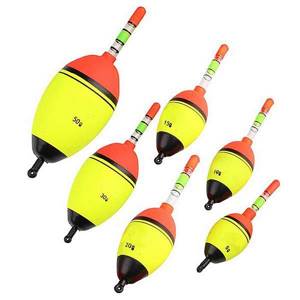
Catching pike with a float does not involve the use of an overly heavy bite alarm. Pike, when attacking live bait, may feel strong resistance and become wary. In most cases, she will refuse the bait.
For this reason, the best option for an angler would be to use an egg-shaped float. Various modifications of it can be found in almost any fishing store.
Regarding leashes (as noted above), it is worth saying the following - they must be strong without the slightest “BUT”. This is why it is customary to use their Kevlar and Metal versions. They are guaranteed to eliminate the negative impact of contact with pike teeth.
Only the presence of such leashes will allow you to successfully catch Pike with live bait and not worry about a possible escape.

You can use a braided fishing line with a diameter of about 0.2 mm. Although the usual 0.25 to 0.4 millimeters is quite suitable for this purpose.
And, of course, where would we be without Good, Sharp hooks. The priority is on the side of Tees, which ensure reliable capture of fish and minimal risk of slipping even when hooking a large specimen.
But this does not mean that Single and Double hooks should be completely abandoned. This is wrong. There is even a known method when anglers, when fishing with live bait, practice using 2 Single hooks with a bait hook in the tail and back area.
Promising Places for Fishing. Where to Fish for Pike?
Well, a natural question, especially for Beginner fishermen: “Where can I catch pike with float tackle, using live bait as bait?”
3 ways to improve your fish bite!

Over 15 years of active fishing, I have found many ways to improve the bite, and here are the most effective:
1. Bite activator . This pheromone additive attracts fish most strongly in cold and warm water. The Fish Hungry bite activator has proven itself to be excellent - Read more…
2. Tackle with increased sensitivity . You should first familiarize yourself with the features of using a particular type.
3. Pheromone baits . They attract the attention of fish, stimulate hunger and cause a schooling reflex, which allows you to collect a lot of fish in one place.
You can get the rest of the secrets of successful fishing for free by reading my other materials on the site.
3 ways to improve your fish bite!
Over 15 years of active fishing, I have found many ways to improve the bite, and here are the most effective:
1. Bite activator . This pheromone additive attracts fish most strongly in cold and warm water. The Fish Hungry bite activator has proven itself to be excellent - Read more…
2. Tackle with increased sensitivity . You should first familiarize yourself with the features of using a particular type.
3. Pheromone baits . They attract the attention of fish, stimulate hunger and cause a schooling reflex, which allows you to collect a lot of fish in one place.
You can get the rest of the secrets of successful fishing for free by reading my other materials on the site.
Here are Some of the Potentially Good Places Where Fishing for Pike with Live bait Will Bring Results:
River branches, Quiet backwaters or Oxbow lakes;
A strip of algae along the coastline on almost any body of water;
Wide river area with no or small current;
Open windows between algae and half-submerged driftwood. Here you, with a high degree of probability, will not be left without a catch. This is absolutely true.

